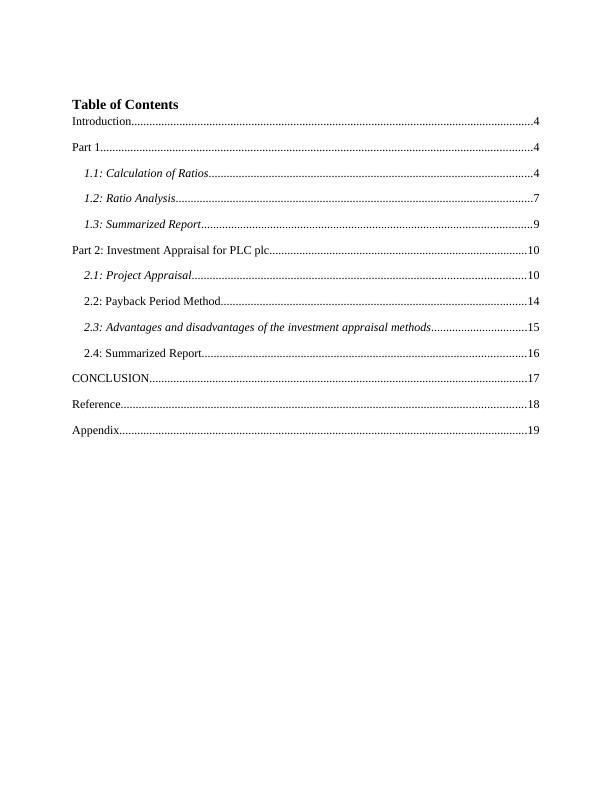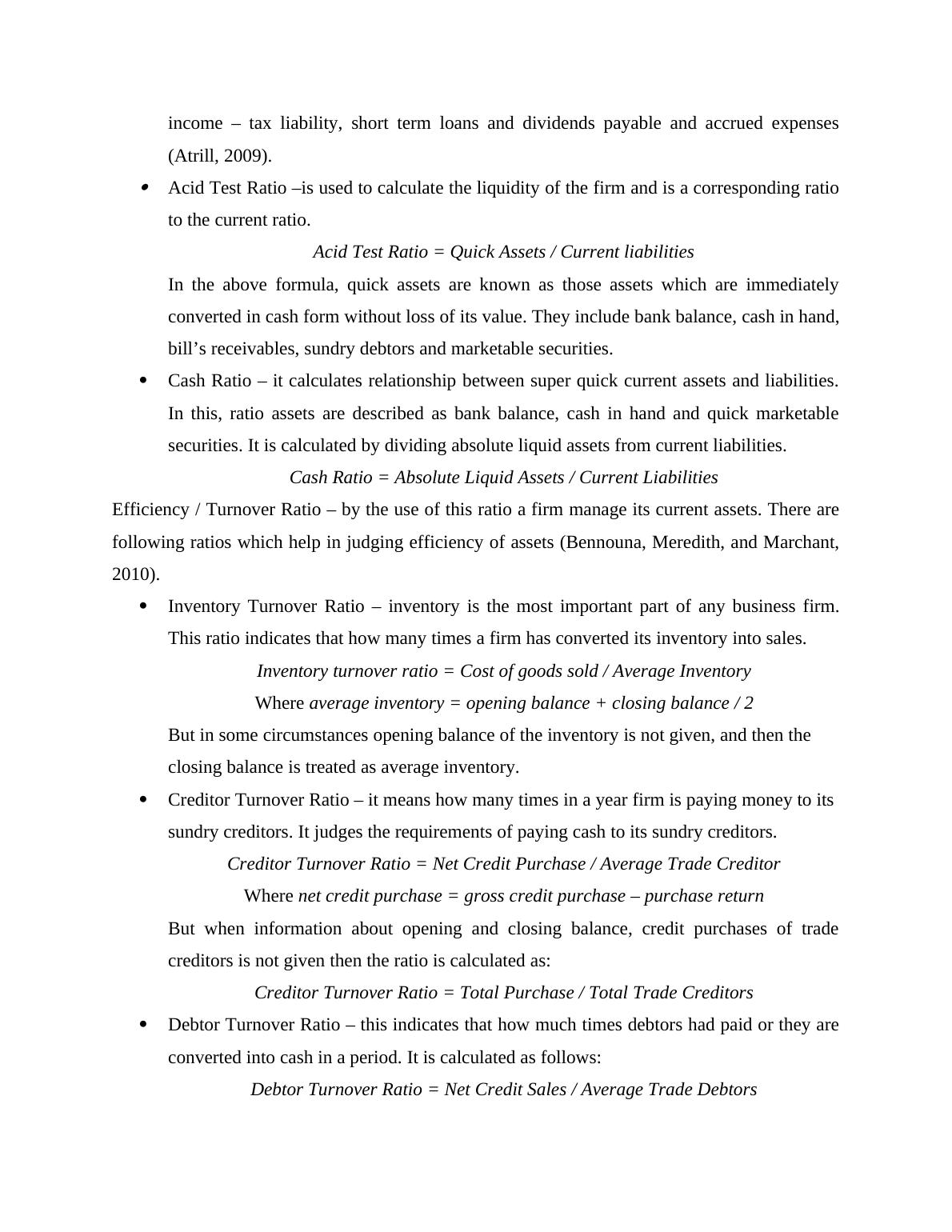(DOC) Strategic Financial Management
Added on 2019-12-03
24 Pages5045 Words246 Views

Table of ContentsIntroduction......................................................................................................................................4Part 1................................................................................................................................................41.1: Calculation of Ratios............................................................................................................41.2: Ratio Analysis.......................................................................................................................71.3: Summarized Report..............................................................................................................9Part 2: Investment Appraisal for PLC plc......................................................................................102.1: Project Appraisal...............................................................................................................102.2: Payback Period Method......................................................................................................142.3: Advantages and disadvantages of the investment appraisal methods................................152.4: Summarized Report............................................................................................................16CONCLUSION..............................................................................................................................17Reference.......................................................................................................................................18Appendix........................................................................................................................................19

List of TablesTable 1: Ratio Analysis of Sainsbury..............................................................................................7Table 2 : Summarized Report..........................................................................................................9Table 3 : Cash Flow for Two Projects...........................................................................................10Table 4 : NPV at 10%....................................................................................................................11Table 5 : NPV of Project 1............................................................................................................12Table 6 : NPV of Project 2............................................................................................................12Table 7 : Payback Period of Project 1...........................................................................................14Table 8 : Payback Period of Project 2...........................................................................................14

IntroductionFinancial analysis of a company indicates its position in the market. This can be done in 2ways either through fundamental analysis or through technical analysis. Both these analysisdepicts companies’ financial information with a difference that former does in tabular form andlatter in chart forms. In modern world, analysts prefer to do technical analysis of the company.Fundamental tool consists of various analysis of the company like that of ratio analysis, balancesheet, income statement etc. It also helps in determining the suitability for investment ofcompany (Arnold, 2005). Part 11.1: Calculation of RatiosSainsbury’s plc shares are traded on London Stock Exchange (LSE) and it is a part of FTSE-100Index.Ratio analysis – is the systematic use of available accounting information required to evaluatethe financial statements of the company. It also reveals the financial and operating performanceof the firm. Ratio analysis includes judgment for a valuable evaluation of the financialstatements. Sainsbury’s performance ratios include liquidity ratio, profitability margin, andefficiency / turnover ratio (Atrill, and McLaney, 2008).Liquidity Ratio –computes the current status of the firm whether it can pay its current liabilitiesin short term or not. This ratio depicts financial solvency of a firm in short term. Every businessfirm is aware that it should not suffer from lack of liquidity. If a firm is not capable to meet itsshort term obligation that means it has a bad credit image. On the other hand, firm with highliquidity is also not attractive as it implies that firm has funds, cash in hand which are not used toearn anything. So, it is essential to balance between liquidity and lack of the same. Liquidityratio can be further classified as – Current Ratio –is the connection between current assets and liabilities. It computes theshort term solvency of a company and can be calculated by dividing current assets withcurrent liabilities.Current Ratio = Current Asset / Current LiabilitiesIn this, current assets includes bank balance and cash in hand, debtors and inventory,marketable securities excluding provision for doubtful debtors and bad debts, prepaidexpenses and bills receivables. Current liabilities entail bills payable, sundry creditors,

income – tax liability, short term loans and dividends payable and accrued expenses(Atrill, 2009).Acid Test Ratio –is used to calculate the liquidity of the firm and is a corresponding ratioto the current ratio. Acid Test Ratio = Quick Assets / Current liabilitiesIn the above formula, quick assets are known as those assets which are immediatelyconverted in cash form without loss of its value. They include bank balance, cash in hand,bill’s receivables, sundry debtors and marketable securities.Cash Ratio – it calculates relationship between super quick current assets and liabilities.In this, ratio assets are described as bank balance, cash in hand and quick marketablesecurities. It is calculated by dividing absolute liquid assets from current liabilities.Cash Ratio = Absolute Liquid Assets / Current LiabilitiesEfficiency / Turnover Ratio – by the use of this ratio a firm manage its current assets. There arefollowing ratios which help in judging efficiency of assets (Bennouna, Meredith, and Marchant,2010).Inventory Turnover Ratio – inventory is the most important part of any business firm.This ratio indicates that how many times a firm has converted its inventory into sales.Inventory turnover ratio = Cost of goods sold / Average InventoryWhere average inventory = opening balance + closing balance / 2But in some circumstances opening balance of the inventory is not given, and then the closing balance is treated as average inventory.Creditor Turnover Ratio – it means how many times in a year firm is paying money to its sundry creditors. It judges the requirements of paying cash to its sundry creditors.Creditor Turnover Ratio = Net Credit Purchase / Average Trade CreditorWhere net credit purchase = gross credit purchase – purchase returnBut when information about opening and closing balance, credit purchases of tradecreditors is not given then the ratio is calculated as:Creditor Turnover Ratio = Total Purchase / Total Trade CreditorsDebtor Turnover Ratio – this indicates that how much times debtors had paid or they areconverted into cash in a period. It is calculated as follows:Debtor Turnover Ratio = Net Credit Sales / Average Trade Debtors

Where net credit sales = gross credit sale – sales return&Average trade debtors = opening + closing balance / 2But when information of trade debtors is not available then it is calculated by followingmethod:Debtor Turnover Ratio = Total Sales / Trade DebtorsAssets Turnover Ratio –shows the relationship between assets and sales. It is computedby following formula: Assets Turnover Ratio = Cost of goods sold / Average Total AssetsProfitability Raito – it measures the firms’ profitability. In the context of profitability, itmeasures the operating efficiency of a firm and its ability to ensure adequate return in terms ofprofits. Profitability ratio includes gross profit margin and net profit margin (Collier, 2012).Gross Profit Margin - it measures the relationship between gross profit and sales. It iscalculated by following formula:Gross Profit Margin = (Gross profit / Net sales) * 100It is the difference between sales and cost of goods sold.Net Profit Margin - it is a relationship between net profits and sales of a firm. Further, itdepicts the efficiency of firm’s management in administrating, manufacturing and sellingthe products. It is calculated by the following formula:Net Profit Margin = (Earnings after Tax / Net Sales) * 100Performance Ratio – It provides relationship between returns of the firm and its totalinvestments. It is further divided in major four parts which are as follows (Dauber, 2012).Return on Assets - it provides a relationship between net profits and net assets. Tocalculate this ratio net profits and assets can be determined in various ways.Return on Assets = (Net Profit after Tax / Average total assets) * 100Return on Capital Employed – it provides relationship between capital employed and netprofit of the firm. Capital employed means funds are supplied by the owners and lenders.Further it can be calculated as follows:Return on Capital Employed = (Net Profit after Tax / Total capital Employed) * 100

End of preview
Want to access all the pages? Upload your documents or become a member.
Related Documents
Financial Performance Analysislg...
|16
|4254
|64
Calculation of Ratios 2 1.1: Calculation of Ratios 2 1.2: INVESTMENT APPRAISAL FOR TESCOlg...
|24
|4852
|496
Report On Financial Analysis Of M&S And Sainsbury Plclg...
|15
|4231
|128
Financial Decision Making for Elton Plc: Business Performance Analysis and Investment Appraisallg...
|16
|5154
|94
Introduction to Financial Analysis: Assignmentlg...
|23
|5902
|229
Report On Asol Ltd & Next Plc Performance For Investment Decisionlg...
|16
|3811
|33
